Hadrian’s Wall carved the northern edge of Roman Britain, standing as a symbol of Roman might and engineering mastery. Erected by Emperor Hadrian’s decree in AD 122, this ancient structure, known as Hadrian’s Wall, now weaves through England’s landscape, inviting adventurers and historians to discover its legacy. In this article, we uncover the purpose behind Hadrian’s Wall, its architectural marvels, and how you can explore its ruins and enduring stories today, all while appreciating the significance of Hadrian’s Wall.
Key Takeaways
- Hadrian’s Wall, as a UNESCO World Heritage Site, exemplifies the architectural and military prowess of the Roman Empire, featuring a complex defense system of forts, milecastles, and turrets across Northern Britain.
- Today, Hadrian’s Wall offers a multifaceted experience with scenic landscapes and a wealth of historical exploration through museums, educational walks, and events, emphasizing both its ancient significance and ongoing cultural value.
- Conservation of Hadrian’s Wall is a collaborative effort led by English Heritage, involving regular maintenance, research, and public engagement, ensuring that visitors uphold preservation practices during their exploration of the site.
The Legacy of Hadrian’s Wall
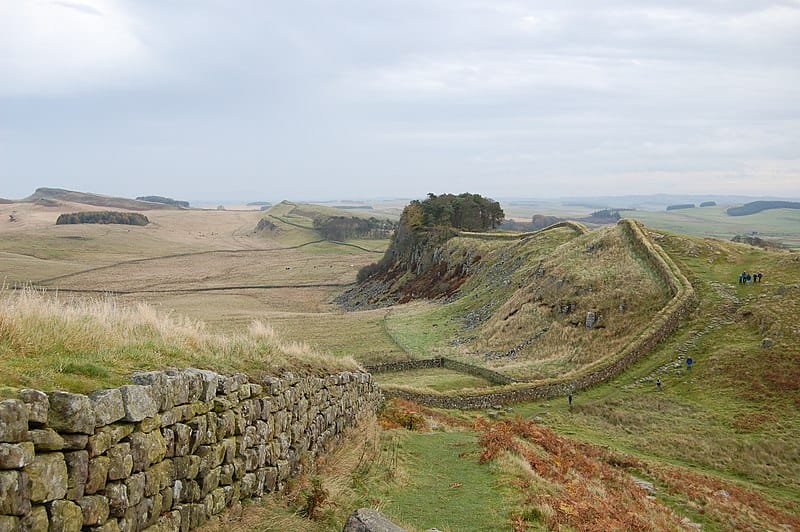
Hadrian’s Wall, the most famous frontier of the Roman Empire, stands as a testament to Roman authority and the reach of the Roman army in Roman Britain. This stone wall, stretching from the banks of the River Tyne near the North Sea to the Solway Firth on the Irish Sea, marked the northernmost boundary of the Roman Empire in Northern Britain.
As not only a wall but a vibrant frontier zone, Hadrian’s Wall was designated as a UNESCO World Heritage Site in 1987, highlighting its global importance and cultural value. Not only the Wall but also other Roman frontiers like the Antonine Wall and the Upper Raetian Limes are part of the larger Frontiers of the Roman Empire World Heritage Site, which includes the wall line as a significant feature.
Emperor Hadrian and his vision
The driving force behind the wall, Emperor Hadrian, reshaped the Roman Empire’s strategy on border control. Unlike his predecessor, Hadrian chose to consolidate and strengthen the Empire’s borders rather than expand them. The construction of the wall in AD 122 was a manifestation of this vision, securing the frontier of the Roman province of Britannia.
Hadrian, recognized for his direct governance style, personally took the time to visit nearly every province in the Empire. His reign is celebrated as a time of relative peace and prosperity, earning him a place among the esteemed ‘Five Good Emperors.’
The purpose behind the wall
The erection of Hadrian’s Wall symbolized a change in Roman strategy, transitioning from expansionism to a focus on defensive fortification. It was built in response to military losses in Britannia and regional unrest. But the Wall was not just a physical barrier; it was also a sophisticated frontier management system.
Guarded gates and deep ditches complemented the Wall’s regulatory function, overseeing cross-border trade and immigration under Roman rule. As a symbol of imperial might, the Wall acted as a physical deterrent to hostile tribes of Caledonia and underscored Rome’s control over its borders through its imposing architectural scale.
Architectural Marvels Along the Wall
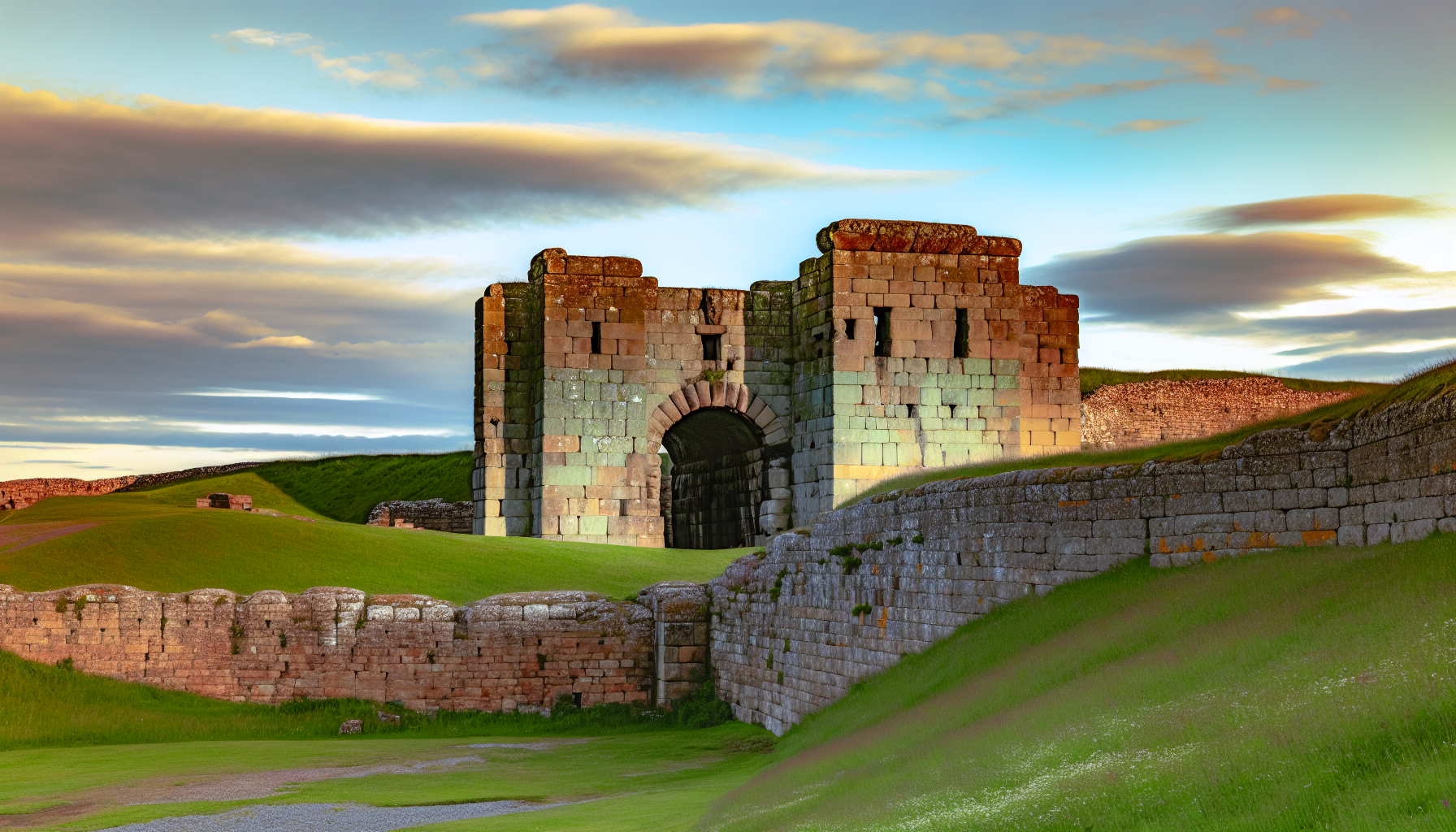
Hadrian’s Wall is a testament to the organizational and engineering capabilities of the Roman Empire. Constructed over four years, it involved thousands of men, showcasing the might of the Roman military machine. Unlike other Roman frontiers, Hadrian’s Wall was built largely in stone, utilizing the local abundance of this material.
The Wall, estimated to originally stand as high as 15 feet with a width varying between 6 and 10 feet, is an impressive structure spanning across Northern Britain. Today, visitors can soak in the grandeur of Hadrian’s Wall at its highest point, Winshields Crag, and enjoy one of the best views at Steel Rigg, both accessible from Northumberland National Park.
Forts and Milecastles

While journeying along the Wall, the forts and mile castles serve as mute guardians, echoing the Wall’s past grandeur. There were originally sixteen forts built directly along the wall, ideally spaced 7 miles apart, though terrain sometimes necessitated variation. These forts, integral to the Wall’s layered defense system, enabled ongoing surveillance, quick communication, and the ability to rapidly deploy troops from their barrack blocks south of the wall.
Milecastles, smaller installations along Hadrian’s Wall, served as fortified gateways and garrisons. Spaced approximately one Roman mile apart, these structures measured about 15m by 18m internally, with stone walls up to 3m thick and likely between 5m to 6m high. Each of the 80 castles was manned by a garrison of 20-30 auxiliary soldiers responsible for controlling passage and potentially acting as customs posts.
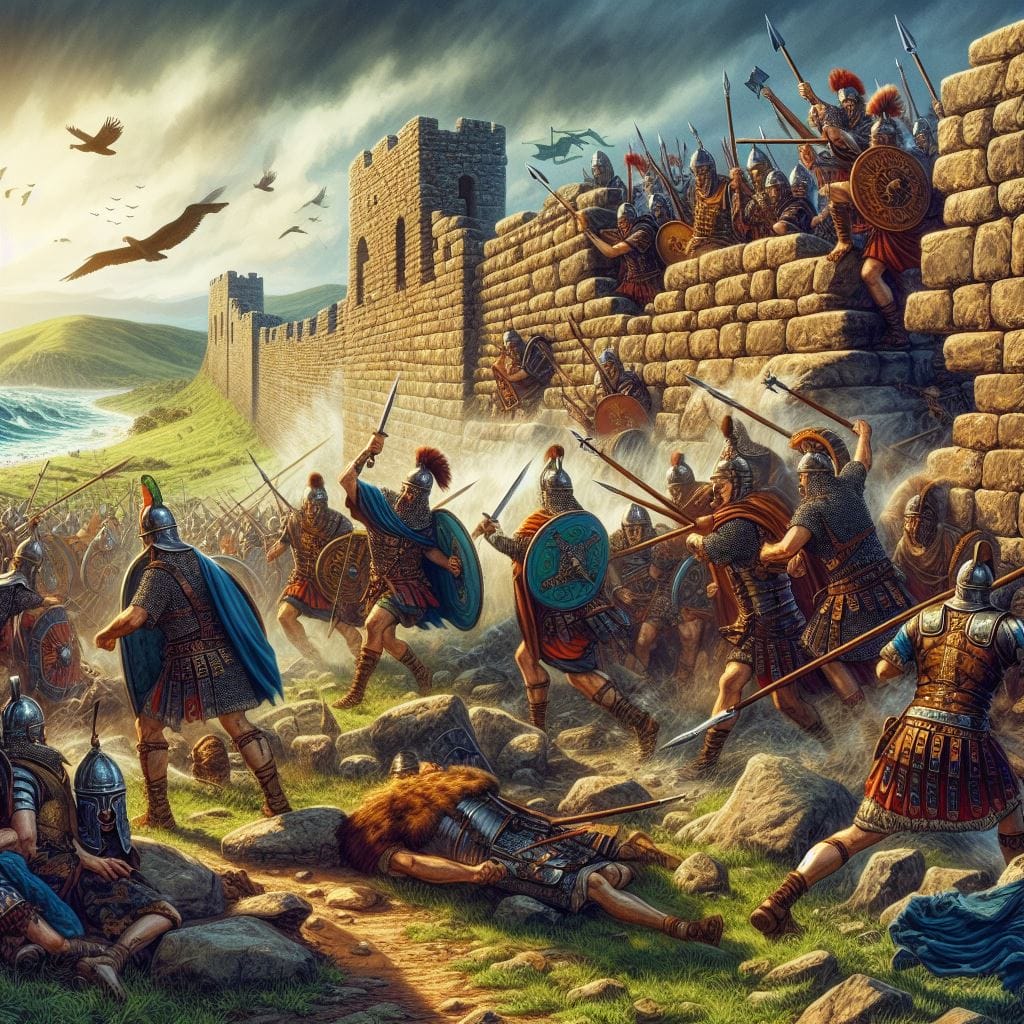
Turrets and watchtowers
Spaced between the mile castles, turrets – a form of watchtower – were pivotal in maintaining the fortification’s surveillance and communication system. These structures were architecturally integrated into Hadrian’s Wall, contributing to the frontier’s defensive capabilities by providing additional layers of observation.
The Milecastle garrisons were responsible for supplying soldiers to staff the intervening turrets, ensuring a robust system of oversight across the wall’s expanse. Each mile castle had an associated pair of turrets positioned about one-third of a Roman mile away, allowing close monitoring and quick communication along the wall.
Experiencing Hadrian’s Wall Today
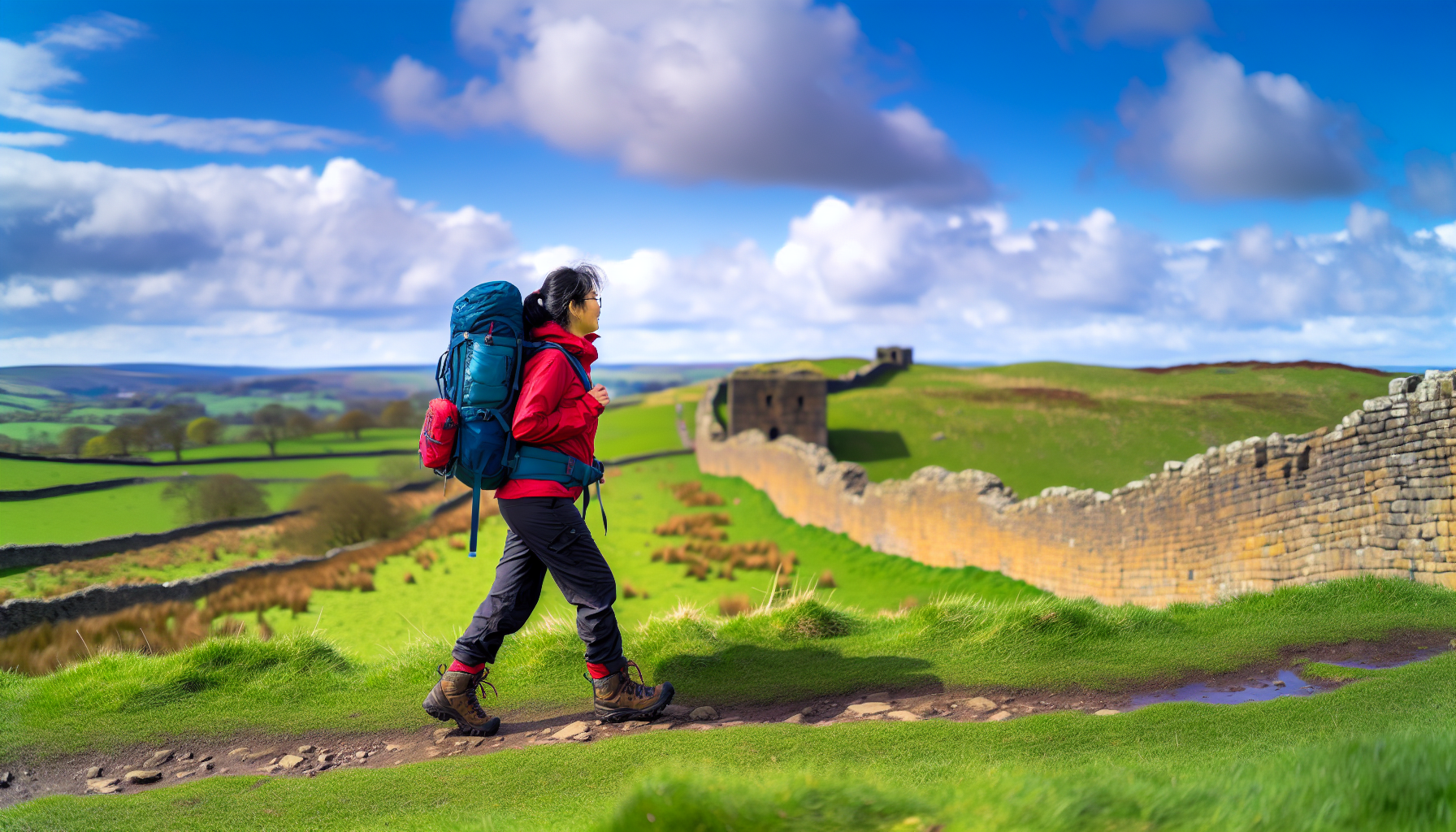
In the present day, Hadrian’s Wall surpasses its status as an ancient monument to serve as a dynamic, thriving landscape where Hadrian’s Wall appears in various forms. Visitors can engage in activities such as exploring Roman forts, hiking historical routes, and enjoying picturesque viewpoints. The ‘Illuminating Hadrian’s Wall event,” which took place in 2010, exemplifies the unique experiences available for visitors, lighting up the Wall from end to end in a dazzling display.
English Heritage promotes the Wall’s historic value through educational resources, public events, and engaging local as well as special-interest communities. Their efforts underscore the importance of preserving the Wall for future generations to appreciate and explore.
Hadrian’s Wall Path
The Hadrian’s Wall Path, a significant attraction, provides a walking journey that traces the historical line from Wallsend to Bowness-on-Solway. This National Trail extends 84 miles (135 km), traversing the entire length of the historic wall, and is a must-do for nature enthusiasts and history buffs alike.
Many visitors choose to explore the Wall by walking the Hadrian’s Wall Path, following the clearly marked trail from east to west or west to east, with the latter often preferred for its favorable weather conditions. The optimal period for walking the Hadrian’s Wall Path is from May to October, with the trail being busiest during summer.
Historical sites and museums
A journey through the historical sites and museums situated along Hadrian’s Wall catapults visitors back in time, offering insights into Roman life and culture. From ongoing excavations at Vindolanda to the Roman artifacts found along the Wall, there’s a wealth of history to explore. Visitors can:
- Engage with archaeologists
- Witness new finds emerging from the soil
- Delve into history with the Edge of Empire HD film for a detailed depiction of a Roman soldier’s life on the wall.
Museums along the Wall showcase a wide array of objects, including:
- statues
- armor
- glassware
- jewellery
- ceramics
- votive offerings
These objects reflect Roman life and culture. Sites like the Senhouse Roman Museum, Tullie House Museum, Art Gallery, and Segedunum offer immersive experiences, from workshops on Roman Carlisle to role-play and interactive exhibits.
Wildlife and Natural Beauty

The allure of the Wall extends beyond its bricks and mortar, encompassing the breathtaking landscapes and rich biodiversity that envelop it. Northumberland National Park, which encompasses Hadrian’s Wall, offers a blend of tranquillity, biodiversity, dark skies, and clean water across 400 square miles of countryside. The park is a haven for species like the golden plover, dunlin, large heath butterfly, and Whooper Swan, as well as unique flora such as wild chive and biting stonecrop.
Visitors to the park can enjoy:
- Breathtaking 360-degree views from Housesteads Roman Fort
- Wildflower meadows and serene lakes at Walltown, the restored Victorian quarry
- Other natural splendors
Greenlee Lough National Nature Reserve, part of the park, serves as a critical sanctuary for wildlife, with sphagnum moss, cranberry, and bog asphodel thriving in protected wet habitats.
Sycamore Gap
One of the most iconic sights along Hadrian’s Wall is the Sycamore Gap, known for its solitary tree. This picturesque spot, nestled between two steep slopes of the Wall, has captured the imagination of many, and it’s also featured in film and television. The movie ‘Robin Hood: Prince of Thieves’ used the scenic backdrop of Sycamore Gap, bringing it to international attention.
Whether you’re a fan of Hollywood blockbusters or not, the sight of the lone sycamore tree standing against the backdrop of the Wall is a sight to behold. The popular television series starring Robson Green highlighted Hadrian’s Wall and surrounding features like Sycamore Gap, introducing them to a wider audience.
Northumberland National Park
Northumberland National Park, located in northern England, spans from Hadrian’s Wall to the Scottish Border, offering an immersive experience for nature lovers. It features:
- Diverse landscapes from moor to valley
- Rivers that showcase a distinctive character
- Ancient flowering hay meadows become a colorful spectacle in summer.
The park consists of picturesque valleys like Tynedale, Redesdale, and Coquetdale, as well as hills including Simonside and the Cheviots. Offering numerous opportunities for walking, cycling, and exploration, it’s the perfect place to unwind and reconnect with nature while soaking up the history of Hadrian’s Wall.
Travel Tips and Accommodations
Considering a visit to Hadrian’s Wall? Be it history buffs, keen hikers, or those seeking a distinctive experience, a plethora of discoveries await. From exploring the Wall by bike, personalized car hire, or taking the AD122 Hadrian’s Wall Country Bus, there are many ways to make the most of your visit. And while there, why not explore nearby Hexham for its stunning architecture and history and enjoy local services such as Michelin-starred dining and tranquil gardens in stone-clad market towns?
For avid hikers planning to tackle the Hadrian’s Wall Path, especially the challenging 23-mile section between Chollerford and Birdoswald, it’s critical to:
- Wear suitable footwear
- Carry weather-appropriate clothing
- Don’t forget to carry your camera to capture the stunning landscapes and timeless architecture.
Transportation methods
Navigating to and around Hadrian’s Wall is simpler than it appears. Rental cars allow visitors to explore at their own pace, with availability at local rental agencies and from Newcastle Airport. The nearby city of Carlisle, as well as towns like Hexham and Haltwhistle, are connected by train and allow further access to the Wall.
If you prefer not to drive, the AD122 Country Bus, tailored for tourists, offers a route that connects major sites along Hadrian’s Wall during tourist season. And, for those who prefer not to self-navigate, guided tours by mini-bus or coach are available, making stops at key points along Hadrian’s Wall.
Places to stay
Securing accommodations near Hadrian’s Wall is straightforward, with a spectrum of options catering to all preferences and budgets. From bed and breakfasts, small inns, and youth hostels such as B&Bs, the Twice Brewed Inn, the George Hotel, and the YHA Once Brewed, there are diverse options ranging from cozy local experiences to comfortable stays with food and drinks.
For a more upscale experience, historic country houses converted into hotels like Langley Castle and Warwick Hall offer luxury accommodations. Self-catering cottages offer guests privacy and flexibility, while camping sites and working farm B&Bs provide a taste of rural life. And for a truly unique stay, try glamping near Hexham Racecourse, in proximity to Hadrian’s Wall.
Preserving Hadrian’s Wall
Preservation and conservation efforts for Hadrian’s Wall are crucial in guaranteeing its enduring legacy for generations to come. Recognized as a UNESCO World Heritage Site since 1987, the Wall’s historical importance is mirrored by extensive preservation efforts. Conservation initiatives encompass routine maintenance, research, and enhancing public involvement, with various grants and funding schemes playing a pivotal role in supporting these activities.
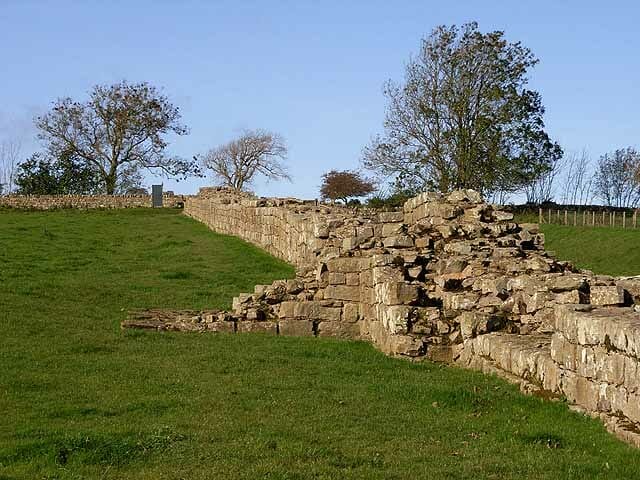
English Heritage, in particular, plays a major role in the preservation efforts, actively engaging with local communities to nurture a sense of collective responsibility for the monument’s future. Their work underscores the importance of preserving the Wall for future generations to appreciate and explore.
The role of English Heritage
English Heritage collaborates with partners, including the Hadrian’s Wall Trust and local authorities, to manage and safeguard the World Heritage Site. Their work includes regular monitoring, prioritized maintenance, providing conservation advice, and developing special projects like the Conservation Plan and the World Heritage Site Management Plan to ensure the long-term protection of the wall.
To protect the Wall’s archaeological significance, English Heritage has implemented the following measures:
- Strictly controlling metal detecting, only permitting it as part of recognized research projects
- Supporting the implementation of the Countryside Stewardship Scheme
- Encouraging research for best conservation practices for elements under cultivation
Through the holiday cottages program, they offer a more immersive historical experience by allowing visitors to stay in refurbished historic buildings.
Guidelines for visitors
Visitors also shoulder responsibility for the preservation of Hadrian’s Wall. Adhering to responsible tourism practices can help protect this precious heritage site. Stick to the marked paths, refrain from climbing on the wall, and carry away all litter.
By respecting these guidelines, you contribute to maintaining the integrity and cleanliness of Hadrian’s Wall, ensuring that it continues to inspire and educate future generations.
Summary
From its monumental scale and architectural prowess to the rich tapestry of history it encapsulates, Hadrian’s Wall is truly a marvel. Whether you’re captivated by its historical significance, charmed by the surrounding natural beauty, or intrigued by the ongoing archaeological work, a visit to Hadrian’s Wall offers a unique and unforgettable experience. As we preserve and protect this priceless piece of history, we’re not only honoring our past but also inspiring future generations.
Frequently Asked Questions
Why is Hadrian’s wall so special?
Hadrian’s Wall is special because it was built as a frontier to the Roman Empire, providing protection and serving as a lasting monument to Emperor Hadrian’s values of peace and stability. The Wall also facilitated cultural exchange and served as a meeting point for soldiers and civilians from various regions.
Does Hadrian’s wall separate England and Scotland?
No, Hadrian’s Wall does not separate England and Scotland. It is entirely inside the borders of England and has never formed a border between the two countries.
How long does it take to walk the Hadrian’s Wall?
It takes between 6-8 days to walk the entire length of Hadrian’s Wall, depending on your fitness level and experience. However, there are shorter treks available that can take anywhere from a couple of hours to a few days.
Does any part of Hadrian’s wall still exist?
Yes, a significant portion of Hadrian’s Wall still exists, especially in the midsection, and it can be followed on foot for much of its length. It was designated as a UNESCO World Heritage Site in 1987.
Is Hadrian’s Wall in England or Scotland?
Hadrian’s Wall is located near the border between modern-day Scotland and England, running from Wallsend and Newcastle on the River Tyne in the east to Bowness-on-Solway on the Solway Firth in the west. It marks the Roman Empire’s northernmost boundary and is less than a mile from the border between England and Scotland.
Hello, my name is Vladimir, and I am a part of the Roman-empire writing team.
I am a historian, and history is an integral part of my life.
To be honest, while I was in school, I didn’t like history so how did I end up studying it? Well, for that, I have to thank history-based strategy PC games. Thank you so much, Europa Universalis IV, and thank you, Medieval Total War.
Since games made me fall in love with history, I completed bachelor studies at Filozofski Fakultet Niš, a part of the University of Niš. My bachelor’s thesis was about Julis Caesar. Soon, I completed my master’s studies at the same university.
For years now, I have been working as a teacher in a local elementary school, but my passion for writing isn’t fulfilled, so I decided to pursue that ambition online. There were a few gigs, but most of them were not history-related.
Then I stumbled upon roman-empire.com, and now I am a part of something bigger. No, I am not a part of the ancient Roman Empire but of a creative writing team where I have the freedom to write about whatever I want. Yes, even about Star Wars. Stay tuned for that.
Anyway, I am better at writing about Rome than writing about me. But if you would like to contact me for any reason, you can do it at [email protected]. Except for negative reviews, of course. 😀
Kind regards,
Vladimir
